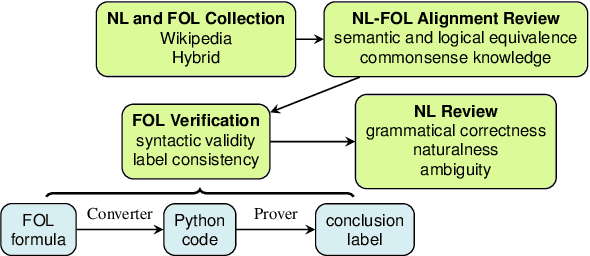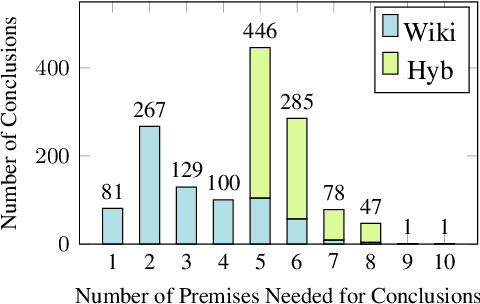Martin Riddell
P-FOLIO: Evaluating and Improving Logical Reasoning with Abundant Human-Written Reasoning Chains
Oct 11, 2024



Abstract:Existing methods on understanding the capabilities of LLMs in logical reasoning rely on binary entailment classification or synthetically derived rationales, which are not sufficient for proper investigation of model's capabilities. We present P-FOLIO, a human-annotated dataset consisting of diverse and complex reasoning chains for a set of realistic logical reasoning stories also written by humans. P-FOLIO is collected with an annotation protocol that facilitates humans to annotate well-structured natural language proofs for first-order logic reasoning problems in a step-by-step manner. The number of reasoning steps in P-FOLIO span from 0 to 20. We further use P-FOLIO to evaluate and improve large-language-model (LLM) reasoning capabilities. We evaluate LLM reasoning capabilities at a fine granularity via single-step inference rule classification, with more diverse inference rules of more diverse and higher levels of complexities than previous works. Given that a single model-generated reasoning chain could take a completely different path than the human-annotated one, we sample multiple reasoning chains from a model and use pass@k metrics for evaluating the quality of model-generated reasoning chains. We show that human-written reasoning chains significantly boost the logical reasoning capabilities of LLMs via many-shot prompting and fine-tuning. Furthermore, fine-tuning Llama3-7B on P-FOLIO improves the model performance by 10% or more on three other out-of-domain logical reasoning datasets. We also conduct detailed analysis to show where most powerful LLMs fall short in reasoning. We will release the dataset and code publicly.
Quantifying Contamination in Evaluating Code Generation Capabilities of Language Models
Mar 06, 2024Abstract:While large language models have achieved remarkable performance on various code generation benchmarks, there have been growing concerns regarding potential contamination of these benchmarks as they may be leaked into pretraining and finetuning data. While recent work has investigated contamination in natural language generation and understanding tasks, there has been less extensive research into how data contamination impacts the evaluation of code generation, which is critical for understanding the robustness and reliability of LLMs in programming contexts. In this work, we perform a comprehensive study of data contamination of popular code generation benchmarks, and precisely quantify their overlap with pretraining corpus through both surface-level and semantic-level matching. In our experiments, we show that there are substantial overlap between popular code generation benchmarks and open training corpus, and models perform significantly better on the subset of the benchmarks where similar solutions are seen during training. We also conduct extensive analysis on the factors that affects model memorization and generalization, such as model size, problem difficulty, and question length. We release all resulting files from our matching pipeline for future research.
L2CEval: Evaluating Language-to-Code Generation Capabilities of Large Language Models
Oct 02, 2023Abstract:Recently, large language models (LLMs), especially those that are pretrained on code, have demonstrated strong capabilities in generating programs from natural language inputs in a few-shot or even zero-shot manner. Despite promising results, there is a notable lack of a comprehensive evaluation of these models language-to-code generation capabilities. Existing studies often focus on specific tasks, model architectures, or learning paradigms, leading to a fragmented understanding of the overall landscape. In this work, we present L2CEval, a systematic evaluation of the language-to-code generation capabilities of LLMs on 7 tasks across the domain spectrum of semantic parsing, math reasoning and Python programming, analyzing the factors that potentially affect their performance, such as model size, pretraining data, instruction tuning, and different prompting methods. In addition to assessing model performance, we measure confidence calibration for the models and conduct human evaluations of the output programs. This enables us to identify and analyze the typical failure modes across various tasks and models. L2CEval offers a comprehensive understanding of the capabilities and limitations of LLMs in language-to-code generation. We also release the evaluation framework and all model outputs, hoping to lay the groundwork for further future research in this domain.
FOLIO: Natural Language Reasoning with First-Order Logic
Sep 02, 2022



Abstract:We present FOLIO, a human-annotated, open-domain, and logically complex and diverse dataset for reasoning in natural language (NL), equipped with first order logic (FOL) annotations. FOLIO consists of 1,435 examples (unique conclusions), each paired with one of 487 sets of premises which serve as rules to be used to deductively reason for the validity of each conclusion. The logical correctness of premises and conclusions is ensured by their parallel FOL annotations, which are automatically verified by our FOL inference engine. In addition to the main NL reasoning task, NL-FOL pairs in FOLIO automatically constitute a new NL-FOL translation dataset using FOL as the logical form. Our experiments on FOLIO systematically evaluate the FOL reasoning ability of supervised fine-tuning on medium-sized language models (BERT, RoBERTa) and few-shot prompting on large language models (GPT-NeoX, OPT, GPT-3, Codex). For NL-FOL translation, we experiment with GPT-3 and Codex. Our results show that one of the most capable Large Language Model (LLM) publicly available, GPT-3 davinci, achieves only slightly better than random results with few-shot prompting on a subset of FOLIO, and the model is especially bad at predicting the correct truth values for False and Unknown conclusions. Our dataset and code are available at https://github.com/Yale-LILY/FOLIO.
 Add to Chrome
Add to Chrome Add to Firefox
Add to Firefox Add to Edge
Add to Edge